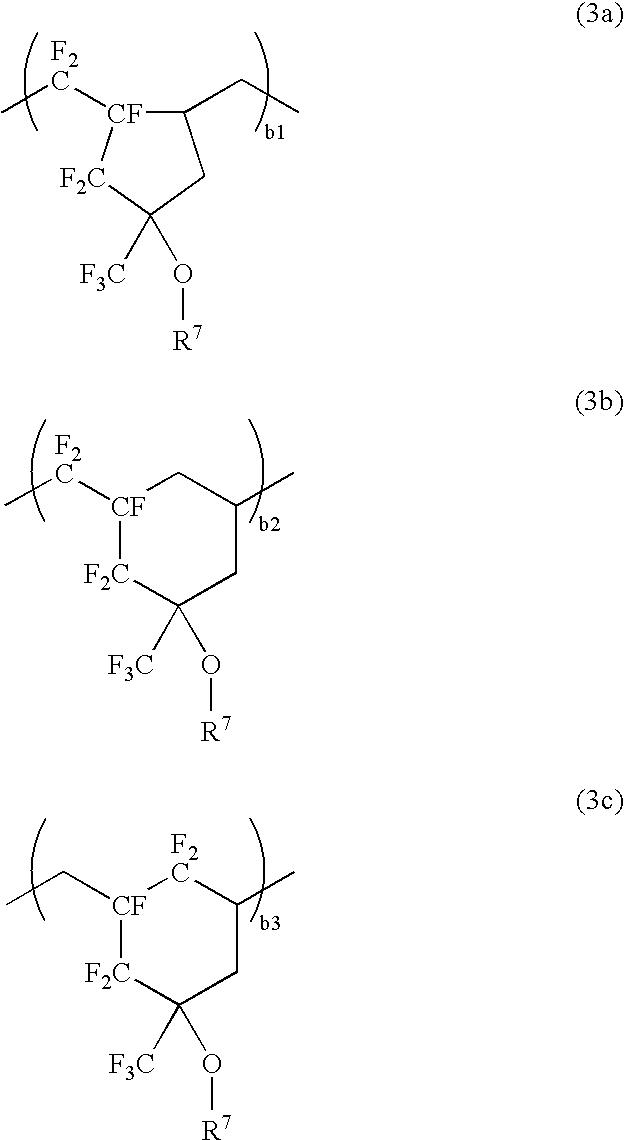Polymers, resist compositions and patterning process
a technology of compositions and polymers, applied in the field of polymers, resist compositions and patterning processes, can solve the problems of resin insufficient transparency, inability to use resists as base resins, and more difficulty in insuring transparency, etc., and achieve good substrate adhesion, high transparency, and good resistance to dry etching
- Summary
- Abstract
- Description
- Claims
- Application Information
AI Technical Summary
Benefits of technology
Problems solved by technology
Method used
Image
Examples
synthesis example 1
Copolymerization of Monomer 1, Monomer 2 and Monomer 3 (0.4:0.3:0.3)
[0164]A 500-ml flask was charged with 8.00 g of Monomer 1, 5.58 g of Monomer 2 and 6.42 g of Monomer 3, all shown below, which were dissolved in 6.67 g of ethyl acetate. The system was fully purged of oxygen, charged with 0.230 g of the initiator AIBN, and heated at 60° C. at which polymerization reaction took place for 24 hours.
[0165]
[0166]The polymer thus obtained was worked up by pouring the reaction mixture into hexane whereupon the polymer precipitated. The procedure of dissolving the polymer in THF and pouring into hexane for precipitation was repeated twice, after which the polymer was separated and dried. There was obtained 14.0 g of a white polymer, designated Polymer 1, which was found to have a Mw of 9,800 and a dispersity (Mw / Mn) of 1.7 as determined by GPC. On 1H-NMR and 19F-NMR analysis, Polymer 1 was found to consist of respective units derived from Monomer 1, Monomer 2 and Monomer 3 in a molar ratio ...
synthesis example 2
Copolymerization of Monomer 1, Monomer 3 and Monomer 4 (0.4:0.3:0.3)
[0167]A 500-ml flask was charged with 7.21 g of Monomer 1, 5.79 g of Monomer 3 and 7.00 g of Monomer 4, shown below, which were dissolved in 6.67 g of ethyl acetate. The system was fully purged of oxygen, charged with 0.207 g of the initiator AIBN, and heated at 60° C. at which polymerization reaction took place for 24 hours.
[0168]
[0169]The polymer thus obtained was worked up by pouring the reaction mixture into hexane whereupon the polymer precipitated. The procedure of dissolving the polymer in THF and pouring into hexane for precipitation was repeated twice, after which the polymer was separated and dried. There was obtained 13.7 g of a white polymer, designated Polymer 2, which was found to have a Mw of 11,000 and a dispersity (Mw / Mn) of 1.7 as determined by GPC. On 1H-NMR and 19F-NMR analysis, Polymer 2 was found to consist of respective units derived from Monomer 1, Monomer 3 and Monomer 4 in a molar ratio of ...
synthesis example 3
Copolymerization of Monomer 1, Monomer 2 and Monomer 5 (0.4:0.3:0.3)
[0170]A 500-ml flask was charged with 9.18 g of Monomer 1, 6.41 g of Monomer 2 and 4.41 g of Monomer 5, shown below, which were dissolved in 6.67 g of ethyl acetate. The system was fully purged of oxygen, charged with 0.264 g of the initiator AIBN, and heated at 60° C. at which polymerization reaction took place for 24 hours.
[0171]
[0172]The polymer thus obtained was worked up by pouring the reaction mixture into hexane whereupon the polymer precipitated. The procedure of dissolving the polymer in THF and pouring into hexane for precipitation was repeated twice, after which the polymer was separated and dried. There was obtained 12.7 g of a white polymer, designated Polymer 3, which was found to have a Mw of 10,500 and a dispersity (Mw / Mn) of 1.7 as determined by GPC. On 1H-NMR and 19F-NMR analysis, Polymer 3 was found to consist of respective units derived from Monomer 1, Monomer 2 and Monomer 5 in a molar ratio of ...
PUM
| Property | Measurement | Unit |
|---|---|---|
| wavelength band | aaaaa | aaaaa |
| wavelength band | aaaaa | aaaaa |
| temperature | aaaaa | aaaaa |
Abstract
Description
Claims
Application Information
 Login to View More
Login to View More - R&D
- Intellectual Property
- Life Sciences
- Materials
- Tech Scout
- Unparalleled Data Quality
- Higher Quality Content
- 60% Fewer Hallucinations
Browse by: Latest US Patents, China's latest patents, Technical Efficacy Thesaurus, Application Domain, Technology Topic, Popular Technical Reports.
© 2025 PatSnap. All rights reserved.Legal|Privacy policy|Modern Slavery Act Transparency Statement|Sitemap|About US| Contact US: help@patsnap.com



